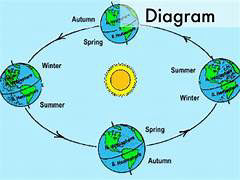
Reason for Seasons Story
The Dance of Seasons
Once upon a time, in a quaint village nestled among rolling hills, there lived a curious young girl named Maya. Maya loved to explore the world around her, and her favorite season was spring. She adored the blossoming flowers, the chirping birds, and the gentle warmth of the sun.
One day, as Maya sat under an ancient oak tree, she wondered aloud, “Why do the seasons change? Why does spring follow winter, and summer follow spring?”
The old oak tree, wise and weathered, seemed to lean in closer. “Ah, my dear,” it whispered, “let me tell you the tale of the seasons.”
The Tilted Axis
Long ago, when the Earth was still young, it spun like a graceful dancer. But something extraordinary happened—a cosmic collision. A celestial body named Theia crashed into our planet, leaving a scar and tilting Earth’s axis. From that moment on, our world waltzed with a slight lean.
Maya’s eyes widened. “But why does this tilt matter?”
The oak tree chuckled. “Patience, my child. Imagine Earth as a spinning top, twirling on its axis. As it pirouettes around the Sun, different parts receive varying amounts of sunlight.”
The Sun’s Embrace
“During summer,” the oak continued, “the North Pole leans toward the Sun. Sunbeams shower the Northern Hemisphere, warming it. That’s when we celebrate long days, picnics, and fireflies.”
“But what about winter?” Maya asked.
“Ah, in winter, the North Pole leans away,” the oak replied. “Sunlight becomes scarce, and snow blankets the land. Animals huddle for warmth, and we sip hot cocoa by crackling fires.”
The Elliptical Dance
“But wait,” Maya pondered, “isn’t Earth closer to the Sun in summer?”
The oak chuckled again. “Indeed, our orbit is elliptical. But it’s the tilt that matters. Earth’s distance from the Sun doesn’t sway the seasons. It’s the Sun’s affectionate touch—or lack thereof—that paints our world.”
The Equinoxes
As the seasons twirled, Maya learned about equinoxes. “What’s an equinox?” she asked.
“Twice a year,” the oak explained, “day and night embrace equally. Spring dances in with the vernal equinox, and autumn pirouettes in with the autumnal equinox.”
The Cosmic Choreography
Maya gazed at the oak, her heart dancing. “So, the seasons are like a cosmic ballet?”
“Yes,” the oak whispered. “A celestial choreography—summer, autumn, winter, spring. Each season whispers secrets to the next, and Earth pirouettes through space.”
Questions and Answers
Why do we have seasons?
Earth’s tilted axis causes the seasons. When the North Pole tilts toward the Sun, it’s summer in the Northern Hemisphere. When the South Pole tilts toward the Sun, it’s winter.
Is Earth closer to the Sun in summer?
Surprisingly, no! Earth’s tilt matters more than its distance from the Sun.
What causes equinoxes?
Equinoxes occur when day and night are equal. Spring begins with the vernal equinox, and autumn arrives with the autumnal equinox.
And so, Maya sat under the oak tree, her mind spinning like Earth itself. She realized that the seasons were not mere changes but a celestial ballet—a dance of light, warmth, and wonder.
And from that day on, whenever spring blossomed, Maya would twirl in the meadows, celebrating the cosmic rhythm that painted her world.